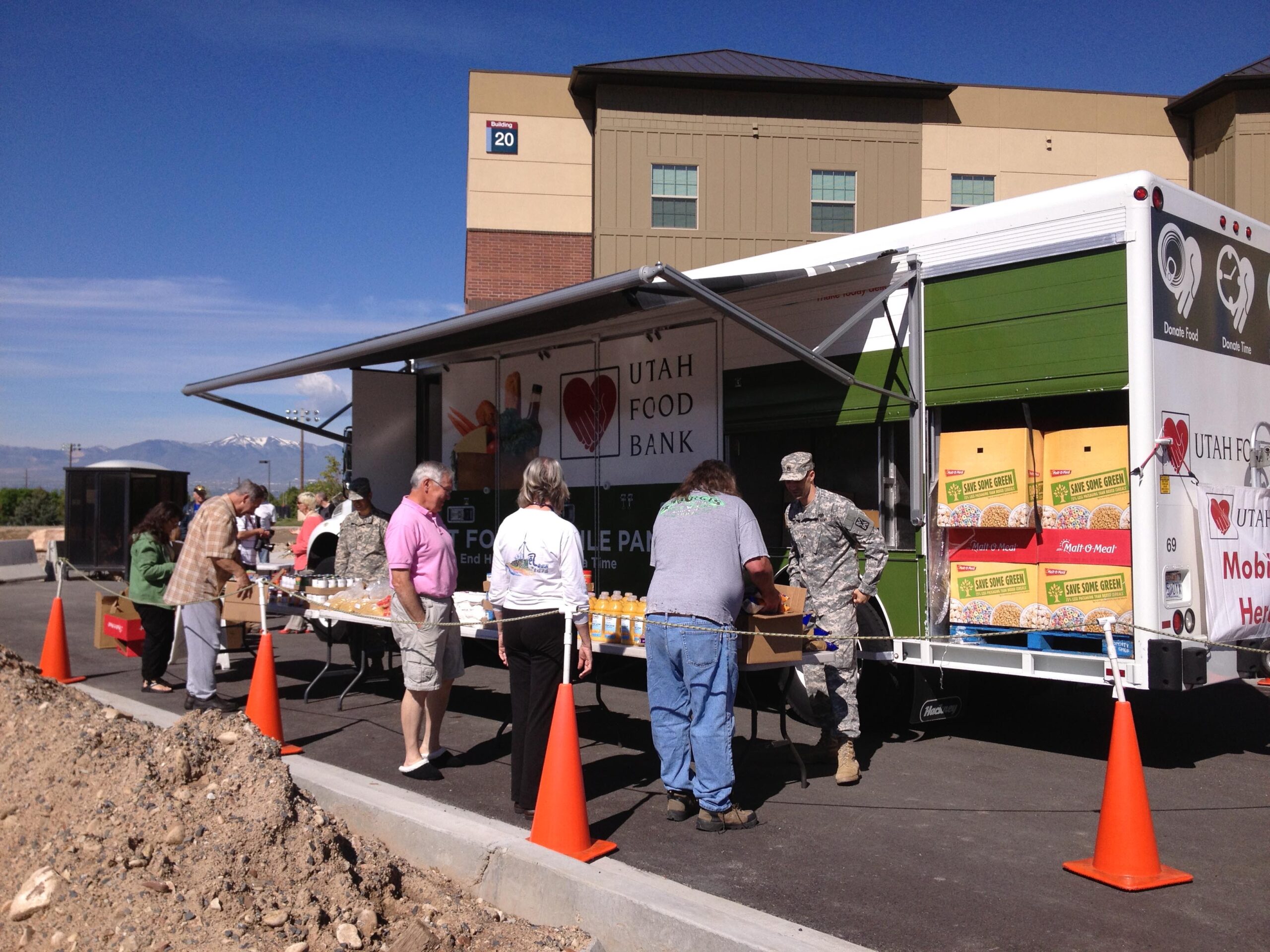Local News
Hunger’s silent battle in Utah County
Published
1 year agoon

The person who cannot pay the rent, the utilities, their gas bill or buy groceries may be your neighbor or friend. The person that does not have a meal to eat tonight or goes without lunch may be your co-worker or your family member. The person who doesn’t eat three meals a day could be your niece or the child who lives next door. Food insecurity is an often suppressed condition where one’s basic sustenance needs are not met.
Children who are hungry may have trouble focusing and learning in school. Beyond academic achievement, “hunger can hurt a child’s ability to build and strengthen their social-emotional skills. When children are hungry, they typically have less energy and ability to focus,” according to the No Kid Hungry organization. A child dealing with hunger may have a harder time forming friendships and interacting with friends, as well as maintaining self-control or listening to instructions.
When adults experience hunger, it can significantly affect their physical and mental health. According to the USDA, there is a strong connection between hunger and chronic diseases like high blood pressure, heart disease and diabetes. Facing hunger can be stressful. Worrying about where your next meal will come from can cause mental health problems such as depression, anxiety and even posttraumatic stress disorder (PTSD). The American Academy of Pediatrics revealed that mothers with school-aged children who face severe hunger are 56.2% more likely to have PTSD and 53.1% more likely to have severe depression. An inability to feed loved ones can result in traumatic effects on a person.
Many people in the community aren’t just skipping lunch or dinner once in a while; they are missing meals daily. The statistics are sobering for Utah as, according to Utah Food Bank, 415,000 Utahns face food insecurity.
“Food insecurity is so much more than just a hunger problem; it’s a collection of anxieties and mental health disparities right in front of Lehi and Utah residents,” said Jordyn Bristol, Miss Timpanogos 2024 and Lehi resident.
“In Utah County, 77,380 residents face hunger, including one in six children who are unsure where their next meal is coming from,” said Ginette Bott, President and CEO of Utah Food Bank. “Food insecurity is truly an issue for college-aged adults in Utah County as well.”
“Almost two in five students enrolled in Utah colleges experienced food insecurity in 2021,” according to a new reportfrom Utahns Against Hunger.
Bristol has advocated to end hunger in Utah for many years. “Going hungry in Utah County is a problem,” Bristol said. “The Hunger Solutions Institute at Utah State University shared a report from the 2022 U.S. Census stating that 9% of Utah County households are food insecure. This number has been increasing due to a 25% inflation increase over the last four years alone.”
“There are many factors that contribute to food insecurity, but experiencing a crisis highly impacts households who experience food insecurity,” said Bott. “A crisis can be anything sudden and traumatic such as loss of a job or death of a spouse. Divorce also influences food insecurity; really anything that puts a family in a financial bind.”
“The risk for food insecurity increases when money to buy food is limited or not available,” Bott continued. “This is a frightening time with inflation, the increase in rent and housing costs, day care costs and an increase in gas prices leaves families stretching their family budgets further than ever before. Many cannot stretch their income as far as it needs to go.”
“Food insecurity is increasing in Utah County primarily due to factors such as rising housing costs and the ending of a pandemic-era. The cost of living in Utah has increased, and we are seeing more families searching for assistance now than ever before. While Utah is technically below the national poverty line, when one in 10 families struggle, we all struggle,” said Bristol.
Community Action Partnerships of Utah shared that 44% of Utah renters and 23.2% of homeowners are cost-burdened, meaning they spend more than 30% of income on housing and utilities, which results in less money for food.
“I have met families driving a Tesla at a drive-thru food bank in need due to a sudden job loss or budget cuts,” Bristol shared. “On a city level, there are areas called ‘food deserts,’ which are where there is a lack of easily accessible healthy food options—such as grocery stores, convenience stores or markets—and are heavily surrounded by less healthy options; fast food locations being closer than a grocery store, for example. High food costs contribute to food insecurity. The average cost of eggs in 2020 was $1.50 for a dozen; we are now seeing them on average cost $3 per dozen. I believe that families below the poverty line are more likely going to choose the cheaper, less healthy options for food.”
The Utah Food Bank has been fighting hunger across the state for over 120 years. “Utah Food Bank has stayed true to their objective of serving those in need throughout our state.” Bott said, “We work tirelessly with community partners and volunteers to continue making an impact and fulfilling our mission of Fighting Hunger Statewide.”
In the fight against hunger the Utah Food Bank has built a new Timpanogos Distribution Center located in Springville which greatly helps with assistance in Utah County. The 77,032 square-foot facility includes 50,364 square feet of warehouse and commercial kitchen space and 26,668 square feet of office and conference room space.
“This facility allows us to offer direct service programs previously unavailable in Utah County and its surrounding areas and it facilitates the expansion of our current programs,” said Bott. “The Timpanogos Distribution Center has been in operation since February of this year and serves the central Utah area, which includes Utah County and 10 other counties. The distribution center in Springville produces canned and boxed goods. Everything that comes in goes out free of charge. There are meats and produce as well as household items available.”
The Utah Food Bank also provides a mobile food pantry program that provides additional support to Utahns facing hunger. The mobile food pantry is a “great and effective way to serve communities that are underserved without a brick and mortar pantry for people to go to,” said Bott. The mobile pantries bring food to areas that lack direct access to a nearby pantry. The mobile pantry serves the Lehi area twice a month.
Bott recommends that anyone facing food insecurity dial 211 for help. 211 is a 24/7 confidential and free resource. Anyone can call to speak with an expert who can help find food, pay bills or access other essential services. Information about 211 is available at https://www.211.org/.
Utah County provides many resources for food insecurity, including food banks, pantries and programs that help people access food.
● Utah Food Bank has been in operation in Utah since 1904 and provides assistance to Utahns facing hunger across the state. The food bank offers direct service programs and emergency food assistance services. Food, volunteers and monetary donations are always needed. Further information and assistance are found at https://www.utahfoodbank.org/get-help/.
● Utah Food Bank’s Mobile Pantry Program provides support to many local communities statewide. The mobile pantry provides service to the Lehi community twice a month at 1149 N 300 W in Lehi from 8:30-9:30 a.m. The next service dates are Dec. 19, 2024 and Jan. 2, 2025. Please arrive early. Information is found at https://www.utahfoodbank.org/programs/mobile-pantry/.
● Community Action Services and Food Bank in Provo is the second largest food bank in Utah and provides comprehensive food assistance services to individuals and families in need across Utah County. They offer a food bank, food pantry, community garden and SNAP outreach. Information can be found at https://www.communityactionprovo.org/ .
● Food and Care Coalition is one of the most proactive homeless resource centers in Utah County and provides nutritional meals daily to individuals, families, and those affected by tragedy. The Coalition is always in need of volunteers and donations. Please reach out to help or for assistance at https://foodandcare.org/.
● Tabitha’s Way is a food pantry for individuals and families of all ages struggling with food insecurity. With three pantries in Utah County located in Spanish Fork, Pleasant Grove and Saratoga Springs, they provide temporary food assistance and resources for self-reliance. Tabitha’s Way always appreciates volunteers and donations. Assistance and information are found at https://tabithasway.org/.
● Centro Hispano Emergency Food Pantry is located in Provo and empowers Latino and Utah families by providing equitable access to information and resources. The pantry provides bilingual services to Hispanic community members. Help can be found at https://centrohispanouc.org/.
● Supplemental Nutrition Assistance Program (SNAP) is located in Provo. Information is found at https://jobs.utah.gov/customereducation/services/foodstamps/requirements.html.
● Women, Infants & Children Nutrition Program (WIC) provides food and nutrition counseling to women and children in need. Information and assistance is online at https://wic.utah.gov/about/apply/.
● Utah Valley University offers a food pantry for students and is open for in-person and online use at https://www.uvu.edu/studentcare/food-pantry/index.html.
● Brigham Young University students experiencing food insecurity may contact the Dean of Students Office and their local Bishop to learn about available resources. Walk-ins, phone calls and emails are all welcome. Please find information at https://foodandhousinginsecurity.byu.edu/.
● Alpine School District offers assistance to those facing food insecurity in the community with the Principal’s Pantry and the Kid’s Closet supports the basic needs of children. Information is found at https://foundation.alpineschools.org/principals-pantry/ and https://foundation.alpineschools.org/kids-closet/ .
● The Alpine Bible Church located in Lehi provides a food pantry for the community. Visit https://www.alpinebible.com/serve/food-pantry/ for information and assistance.
● Utahns Against Hunger is an organization that is committed to helping people in Utah gain access to the food help they need through charitable organizations and Federal Nutrition Programs. Please contact https://www.uah.org/ for assistance.
By raising awareness, tackling the root causes and making ourselves part of the solution, we can help lessen the severity of hunger’s silent battle in Utah County.
“Ten percent of the state’s children are food insecure. This is also a problem they unfortunately cannot control. With a state so focused on family, we need to become educated and support statewide legislation that helps fight hunger. I feel legislation that supports access to free or reduced lunch programs for children are important,” said Bristol.
Through education, we can support programs and legislation in the state that support those facing hunger.
“Backed by Provo Representative Tyler Clancey, The American Heart Association of Utah as well as The Policy Project’s ‘The Focused Student Project,’ there is a state bill being presented in the upcoming state legislative session asking for an increase in the Education budget to go towards free school lunch programs for children. This is a crucial amendment to ensure students are being fed,” said Bristol.
Engaging in advocacy is the public support that can help in reducing food insecurity. People can become informed and contact elected officials to leverage their influence and raise awareness. Together we can end hunger through action and advocacy. Individuals can donate to reputable organizations that focus on alleviating food insecurity. Financial contributions as well as volunteerism can help reach those in need within our community.
“This is not a public health issue we can deal with at a later time while there are hungry children. My favorite quote is, ‘If not me, then who?’ I urge Utahns to use their skills and community attachments to cling to this issue and fight for the future of this community,” said Bristol.

You may like
-


Local child protection group takes its fight against big tech to the FTC
-


Willowcreek administrators spark holiday cheer for students
-


Teen entrepreneurs showcase innovation at Christmas market
-


Why a new mineral find near Utah Lake is drawing national attention
-
Aspen Peaks School Board approves budget, launches staff searches and boundary study
-


Lehi’s TSSD sewer rates to increase over 100% by 2027
-


Lehi Free Press
-


Falcon boys take 2nd in hoops tourney
-


Lehi hosts largest Chanukah celebration in Utah County history
-


Falcon girls hoops goes 1-2 in tight stretch

